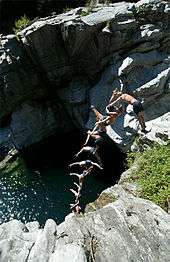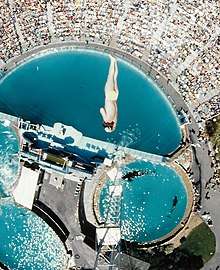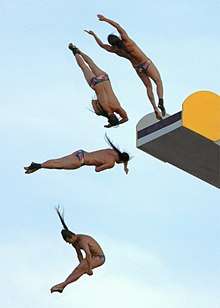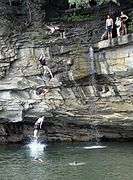High diving
High diving is the act of diving into water from relatively great heights. High diving can be performed as an adventure sport (as with cliff diving), as a performance stunt (as with many records attempts), or competitively during sporting events. It debuted as a sport at the 2013 World Aquatics Championships in Barcelona.[1][2] In the world championships, men jump from a 27-metre-high (89 ft) platform while women jump from a 20-metre-high (66 ft) platform. In other official competitions, men generally dive from a height of 22–27 metres (72–89 ft) while women dive from a height of 18–23 metres (59–75 ft).[3] The sport is unique in that athletes are often unable to practice in an authentic environment until the days leading up to a competition.[1] High diving has been designated a sport separate from regular diving by FINA. High divers have achieved speeds of descent of 96 kilometres per hour (60 mph).
History
.jpg)
Initially, diving as a sport began by jumping from "great heights". Then it was exclusively practiced by gymnasts as they found it exciting with a low probability of injury. It then evolved into "diving in the air" with water as the safety landing base. Efforts by Thomas Ralph to name the sport "springing" were not realized, as the term "diving" was by then firmly rooted. It soon became a sporting event pursued by many enthusiasts. In the early years of the sport, finding suitable places to jump was an issue, and people started jumping from any high place – in Europe and the United States they started jumping from bridges, then diving head first into the water. This evolved into "fancy diving" in Europe, and, particularly in Germany and Sweden, as a gymnastic act. The sport further improved with gymnastic acts being performed during the diving process, and was then given the names "springboard diving" and "high fancy diving", which were events in the Olympics of 1908 and 1912. The first diving event as a sport, however, was in 1889 in Scotland with a diving height of 6 feet (1.8 m).[4] Today, in Latin America, diving by professionals from heights of 100 feet (30 m) or more is a common occurrence.[5]
Cliff diving has been documented as far back as 1770 when Kahekili II, king of Maui, engaged in a practice called "lele kawa," which in English means jumping feet first into water from great heights without making a splash.[6] The king's warriors were forced to participate to prove that they were courageous and loyal to the king. The practice later developed into a competition under king Kamehameha I, and divers were judged on their style and amount of splash upon entering the water.
On 14 January 1933, Dutchman Lou Vlasblom made a well documented dive from the top of one of the towers of the Rotterdam Koningshaven bridge from a height of 65 meters.[7]
The first female world champion in this sport was Cesilie Carlton of the United States, who won the first gold medal at the 2013 World Aquatics Championships with a total score of 211.60.[8][9] The first male world champion was Orlando Duque of Colombia who received a score of 590.20.[10]
Overview
Pool diving
Until 2018, the only permanent regulation-size high diving platform in the world is located in Austria, but it is not used during the winter period. In 2018, Zhaoqing Yingxiong High Diving Training Center,[11] which contains the first year-round regulation-size high diving platform, opened at the Zhaoqing Sports Center in Zhaoqing, China.[12] The training practice is generally done on 10-metre-high (33 ft) platforms. The "competition dives" are collectively put in place in pieces, similar to the way a dress is made.[13] Dives such as five somersault dives can thrill, but some competitors prefer to perform simpler dives.[13]
Outdoor diving
Some outdoor diving involves launching from significant heights. One such diver noted, "There is adrenalin, excitement, danger – so many different energies go through your mind when you jump off. That goes away and then you hit the water come up and it's a massive elation, you feel such self achievement." A rescue team of scuba divers may be involved in some instances, and are required for any official competitions.
Cliff diving

Cliff divers practice the different components of their dives in isolation and only execute the complete dive during championship competitions. Cliff dives are considered extremely difficult and dangerous,[14] a challenge to every competitor; in addition to the physical challenges, they can be mentally challenging to perform.
Events
Both men and women participate in the High Diving World Championships, but the diving height for women is limited to 20 metres (66 ft). The Red Bull Cliff Diving World Series is held annually and draws crowds of up to 70,000 people. Participants dive from a variety of locations including castles, cliffs, towers, bridges, and the Copenhagen Opera House.[15] Three well-known divers – Gary Hunt, Blake Aldridge and Tom Daley – the last who were champions at the 2008 Olympic synchro, were set to dive on a 27-metre-high (89 ft) platform at the Moll de la Fusta, Barcelona's port; this dive was to be achieved in 3 seconds at a speed of 60 kilometres per hour (37 mph). Huge Hunt of the United Kingdom won the August 2015 FINA world championships. The average age of the participants in this event was 30. Efforts are being made by gymnasts to make this sport an Olympic event for the 2020 Summer Olympics held in Tokyo, Japan, or the 2024 Summer Olympics to be held in Paris, France.[13]
World record high dives
There is considerable debate surrounding record claims for the highest dive, which largely revolves around criteria for what constitutes a valid dive.[16] ABC's Wide World of Sports produced world record high dives for its Emmy award-winning sports anthology show for more than a decade. They required contestants to dive or execute at least one somersault and exit the water without the assistance of others. In 1983 Wide World of Sports produced its last World Record High Dive at Sea World in San Diego. Five divers (Rick Charls, Rick Winters, Dana Kunze, Bruce Boccia and Mike Foley) successfully executed dives from 172 ft.[17] In 1985 Randy Dickison dove from 174 ft 8 inches at Ocean Park in Hong Kong but sustained a broken femur and could not exit the water on his own.[18]
In 1987, Olivier Favre attempted a double back somersault from 177 ft but broke his back upon impact and had to be rescued.[19] Laso Schaller's 2015 jump from a 193 ft cliff in Switzerland may not be considered a dive based on ABC's criteria (one somersault needed);[20] however, he is the current record holder for Highest dive from a diving board according to the Guinness Book of Records,[21] simultaneously holding the Highest Cliff Jump record for the same jump.[22]
Men
| Date | High diver | Place | Height | Video | Notes |
|---|---|---|---|---|---|
| 4 August 2015 | Maggia, Switzerland | 58.8 m (192 ft 10 in) | [23] | Highest dive from a high diving board and Highest Cliff Jump as per Guinness Book of World Records [21][22] | |
| March 1983 | SeaWorld San Diego | 52.4 m (172 ft) | [24] | ABC's Wide World of Sports - World Record High Dive Challenge | |
| March 1983 | SeaWorld San Diego | 52.4 m (172 ft) | [25] | ABC's Wide World of Sports - World Record High Dive Challenge | |
| March 1983 | SeaWorld San Diego | 52.4 m (172 ft) | [26] | ABC's Wide World of Sports - World Record High Dive Challenge | |
| March 1983 | SeaWorld San Diego | 52.4 m (172 ft) | [27] | ABC's Wide World of Sports - World Record High Dive Challenge | |
| March 1983 | SeaWorld San Diego | 52.4 m (172 ft) | [28] | ABC's Wide World of Sports - World Record High Dive Challenge | |
| 7 April 1985 | Ocean Park Hong Kong | 53.2 m (172 ft 8 in)[29] | [30] | Failed attempt, multiple fractures of the left leg prevented diver from exiting the pool unassisted.[29] | |
| 30 August 1987 | Villers-le-Lac, France | 53.9 m (177 ft) | [31] | Failed attempt. Broke his back upon impact with water and had to be rescued.[16] | |
| 27 September 1997 | Žďákovský most, Czech republic | 58.28 m (191 ft) | [32] | This was a jump not a dive. Fracture of the thoracic vertebrae and other internal injuries, no surgery[33] |
Women
| Date | High diver | Place | Height | Video | Notes |
|---|---|---|---|---|---|
| 1982 | Rome, Italy[29] | 33.3 m (109 ft 4 in) | |||
| 7 April 1985 | Ocean Park Hong Kong | 36.8 m (120 ft 9 in) | [30] |
Health implications
Some research suggests that the impact associated with high diving could have negative effects on the joints and muscles of athletes.[1] To avoid injury to their arms upon impact with the water, divers from significant heights may enter the water feet first.
Image gallery
 Dana Kunze
Dana Kunze A composite dive from Orlando Duque.
A composite dive from Orlando Duque. Cliff Diving
Cliff Diving- A event in La Rochelle, France.
.jpg) A person dives from the 27.5 metre platform on La Salve bridge.
A person dives from the 27.5 metre platform on La Salve bridge. Amateur cliff diving
Amateur cliff diving
See also
- 2014 FINA High Diving World Cup
- La Quebrada Cliff Divers
- List of World Aquatics Championships medalists in high diving
- Red Bull Cliff Diving World Series – annual international series of cliff diving events that was established in 2009
Olympic events
- Diving at the 1912 Summer Olympics – Men's plain high diving
- Diving at the 1912 Summer Olympics – Women's plain high diving
- Diving at the 1920 Summer Olympics – Men's plain high diving
- Diving at the 1924 Summer Olympics – Men's plain high diving
References
- Napolitano, Salvatore; Di Tore, Pio Alfredo; Raiola, Gaetano (2013). "High Diving: Evaluation of Water Impact and Considerations on Training Methods" (PDF). Journal of Human Sport and Exercise. 8 (2): 283–289. doi:10.4100/jhse.2012.8.Proc2.30.
- Adrega, Pedro; Chiarello, Sarah (29 July 2013). "High Diving, Day 1: Pure adrenalin in the port of Barcelona!". FINA. Archived from the original on 4 August 2013. Retrieved 31 July 2013.
- "General Rules and Regulations for International Competitions" (PDF). World High Diving Federation. Archived from the original (PDF) on 2 February 2016. Retrieved 11 September 2015.
- Dubey, H.C. (1 January 1999). Dph Sports Series-Diving. Discovery Publishing House. p. 2. ISBN 978-81-7141-478-9.
- Crego, Robert (January 2003). Sports and Games of the 18th and 19th Centuries. Greenwood Publishing Group. pp. 136–. ISBN 978-0-313-31610-4.
- "History: The real roots of cliff diving are found at Kaunolu, on the Hawaiian island of Lana´i" (PDF). World High Diving Federation. Retrieved 11 September 2015.
- De bronnen van Clio: Doodssprong (2) : springers of duikers te Rotterdam?
- "High Diving, Day 2: History was made: Cesilie Carlton (USA) is the first World champion!". FINA. 30 July 2013. Archived from the original on 23 August 2016. Retrieved 9 September 2015.
- Rogers, Iain (30 July 2013). "American Carlton takes inaugural high diving gold". Reuters. Retrieved 31 July 2013.
- Wilson, Joseph (31 July 2013). "Orlando Duque wins 1st high diving world title". The Big Story. Associated Press. Retrieved 11 September 2015.
- "Zhaoqing ready for the FINA High Diving World Cup 2019 - Xinhua | English.news.cn". www.xinhuanet.com. Retrieved 26 May 2019.
- "VIDEO: Zhao Qing High Diving Stadium Opens In China". Swimming World News. 8 December 2018. Retrieved 26 May 2019.
- "High Diving, a Crowd-Pleasing Sport, Pursues an Olympic Platform". The New York Times. 5 August 2015.
- Harris, Rob. "The Dangers of Jumping into Water From Heights". Livestrong. Retrieved 10 September 2015.
- Hope, Nick (August 2013). "US great Greg Louganis wants high diving at Olympic Games". BBC Sport. Retrieved 9 September 2015.
- lolajones (7 April 2009). "Seriously extreme diving – the High Diving record, Dana Kunze, and the Deep Diving record, Nuno Gomes". xtremesport4u.
- ABC's Wide World of Sports - World Record High Dive Challenge 1983 (172 ft) - YouTube
- Randy Dickison's World Record High Dive from 172 feet 8 inches in Hong Kong 1986 - YouTube
- Olivier Favre - World Record Highest Dive - 177ft - 54 m - YouTube
- Laso Schaller's World-Record Jump Was Not a World-Record Dive
- "Highest dive from a high diving board (Male)".
- "New photos: Laso Schaller completes the highest cliff jump ever attempted". 3 December 2015.
- High Jump World Record with Laso Schaller 58.80 Meter / 192ft Cliff Diving. YouTube.
- ABC's Wide World of Sports - Rick Winters World Record High Dive. YouTube.
- ABC's Wide World of Sports - Rick Charls World Record High Dive. YouTube.
- ABC's Wide World of Sports - World Record High Dive Challenge 1983 (172 ft). YouTube. 20 February 2011.
- ABC's Wide World of Sports - World Record High Dive Challenge 1983 (172 ft). YouTube. 20 February 2011.
- ABC's Wide World of Sports - World Record High Dive Challenge 1983 (172 ft). YouTube. 20 February 2011.
- "High Divers Set Marks at Hong Kong Event". The New York Times. Associated Press. 7 April 1985. Retrieved 9 September 2015.
- World Record Highest Dives (Randy Dickison 174'8" and Lucy Wardle (Streeter) 120'9"). YouTube. 26 November 2008.
- Olivier Favre - World Record Highest Dive - 177ft - 54 m. YouTube. 21 August 2010.
- VTS. YouTube. 21 March 2011.
- Rudolf Bok (1999). Jsem kaskadér [I'm a Stuntman]. Olympia. ISBN 978-80-7033-591-8.
Further reading
- Crouse, Karen (5 August 2015). "High Diving, a Crowd-Pleasing Sport, Pursues an Olympic Platform". The New York Times. Retrieved 7 September 2015.
- "Breathtaking, daring moments from world's biggest diving competitions". CNN. 27 July 2015. Retrieved 7 September 2015.
- Mercier, H.; Ammann, W.J.; Deischl, F.; Eisenmann, J.; Floegl, I.; Hirsch, G.H.; Klein, G.K.; Lande, G.J.; Mahrenholtz, O.; Natke, H.G. (2012). Vibration Problems in Structures: Practical Guidelines. Birkhäuser. pp. 25–28. ISBN 978-3-0348-9231-5. – Contains content about high diving platforms
External links
| Wikimedia Commons has media related to High diving. |